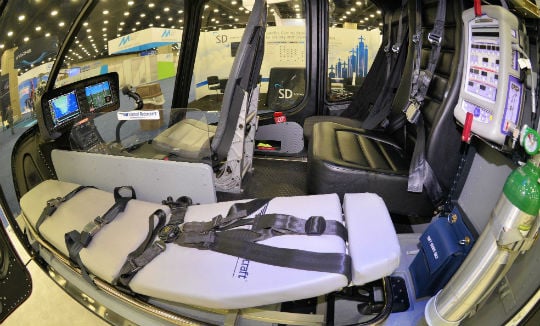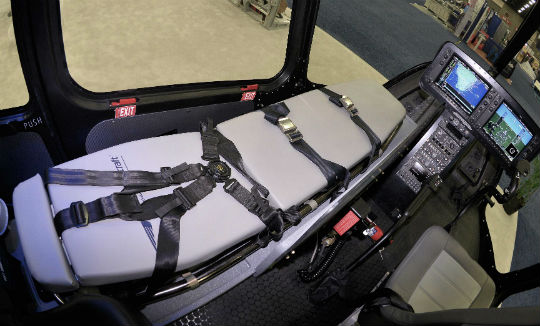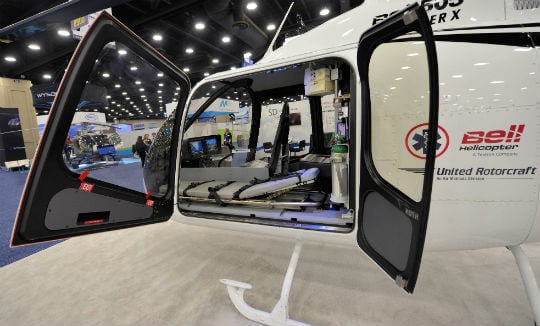
United Rotorcraft unveiled its EMS interior concept for the Bell 505 Jet Ranger X at HAI Heli-Expo in Louisville, Ky. Skip Robinson Photo
Completions specialist United Rotorcraft has unveiled an emergency medical services (EMS) interior for the upcoming Bell 505 Jet Ranger X that can be installed in less than 30 minutes.
The interior, which was on display in a full-scale 505 mockup in United Rotorcraft’s booth at HAI Heli-Expo 2016, sees two of the aircraft’s five seats removed to make room for a basic litter kit, a locking system, a fluid pan, and a modular equipment rack, allowing the aircraft to carry one pilot, two crewmembers, and one patient.
Frank Graham, senior director of global sales and marketing at United Rotorcraft, said weight, price and simplicity were the key drivers in the development of the interior; while the final weight and cost will depend on how extensively the equipment rack is populated, Graham said the cost would be kept low in line with the pricing ethos behind the aircraft, and the weight of the interior at the show increased the aircraft’s net weight by about 60 pounds.

United Rotorcraft believes the 505’s low cost will make it an excellent HEMS aircraft for developing countries. Skip Robinson Photo
Bell Helicopter has received more than 350 letters of intent for the light single-engine 505, which is due to be certified later this year, with deliveries beginning shortly afterwards. Bell has stated that the aircraft will cost around $1 million, and according to Graham, it was this that first opened United Rotorcraft’s eyes to the 505 being a viable EMS aircraft.
“When Bell started to introduce the 505 helicopter, we looked at it and thought it would be an excellent air medical aircraft for developing countries, specifically from the standpoint of price,” he said. “We saw that and said, ‘They’re going to sell a lot of these, but it’s a JetRanger’ — and JetRangers have historically had challenges [as an EMS aircraft] because they were so small.”
But when they had the chance to look inside a mockup of the aircraft, United Rotorcraft saw the possibilities provided by the design of the helicopter’s interior. “The flat floor opened the doors for us,” said Graham. “When you consider the ergonomics of loading a patient into or out of a helicopter, when you’re loading above your waist, it becomes challenging — and then you have to navigate around things inside the helicopter. Bell eliminated 100 percent of that by making it a flat floor aircraft with an open cabin design. So we instantly said, ‘Alright, this will work.’ “

The 505 EMS interior is configured for one pilot, one patient on a stretcher, and two crewmembers. Skip Robinson Photo
To keep the cost of the interior low, and to keep the product development and engineering as quick and simple as possible, the majority of the interior uses already existing products, or products that have been modified only slightly to allow for a speedy installation and removal in the aircraft.
The latter was another important design consideration. “We quickly determined that the likelihood of a dedicated [EMS] 505 is not nearly as strong as a multimission application, so we directed our engineers to include a tool-less installation in the design,” said Graham. “We wanted to offer this kit that would attach to the back wall the same way the OEM seats do, and have the litter kit attach to existing hard points in the floor of the OEM helicopter. So, with no tools required, you could convert the aircraft from a five-passenger aircraft to a three-passenger and one-patient configuration in less than 30 minutes.”
While United Rotorcraft clearly hopes an EMS 505 will find a market in developing countries, Graham suggested the ability to transform a public service 505 into a medevac aircraft could also provide a crucial multimission capability for local or state agencies in more mature markets.

Weight, price and simplicity were the drivers in the development of the interior, said United Rotorcraft’s Frank Graham. Skip Robinson Photo
“From that perspective we see quite a bit of potential,” said Graham. “It gives the airborne law enforcement agency or the municipality justification for the aircraft, because now they’re not buying an aircraft just for law enforcement, they have another application that they can use the aircraft for.”
Graham said any further United Rotorcraft customizations for the 505 — such as a law enforcement interior — would have to be market driven. “Obviously we’ve made the decision that there’s a viable EMS market for that helicopter in terms of selling some kits to multimission operators. Until a law enforcement agency comes and says we are going to buy some of these . . . we won’t be that proactive in the airframe, just because our core competency is EMS.”
The EMS 505 mockup certainly generated a lot of interest at the United Rotorcraft booth at Heli-Expo. “We’ve clearly proven to the industry that you can do EMS in this aircraft, and that our conceptual interior is quite mature — you can touch it and feel it, it’s real product that’s flying in other aircraft today,” said Graham.
United Rotorcraft plans to certify the EMS interior once the aircraft receives its type certificate (scheduled before the end of 2016), and while it is not currently taking orders, it said its list of interested parties is growing, and it will continue to provide updates to these people as the design is finalized and the aircraft nears type certification.









